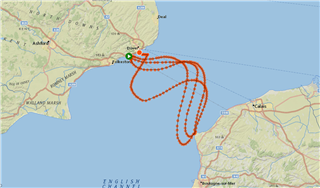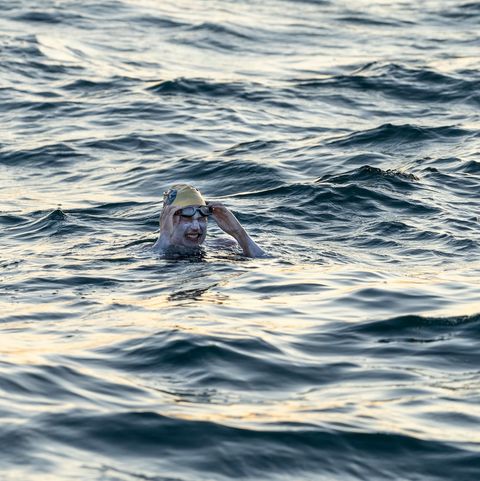Even one crossing of the English Channel is considered a great feat for an open-water swimmer. Sarah Thomas, noted marathon swimmer, just broke a record when she swam the channel four times without stopping. That’s from England to France and back, and then the same thing again. The more than 130-mile trip took her about 54 hours and 13 minutes, beginning just after midnight on Sunday BST and finishing Tuesday morning at around 6:30 AM BST.
One “lap” of the channel is about 21 miles, but swimmers usually end up swimming far more than that; in order to catch the right currents and land in the correct place, you have to swim in curves. In a marathon swim like this, a mile could take 20 minutes. A mile by the very same swimmer could take an hour. It depends on currents, chop, wind, waves, and, of course, the swimmer’s mental and physical state. And the swimmer generally has hours of salt water—which can feel caustic to the mouth and nose in even a short time—and jellyfish to contend with. Reports say the last leg was especially choppy, dark, and windy.

The channel is notoriously cold and wavy, especially at night, and filled with often unfriendly currents that can stall swimmers for hours. “Channel rules” mandate that you wear just a regular swimsuit, goggles, and a swim cap (no wetsuit). Reports from Thomas’ support crew, in a boat next to her, said the water temperature ran about 64.4 to 66.2 degrees.
Thomas, who’s based in Colorado, already distinguished herself as an extraordinary athlete: She holds the record for the longest unassisted open-water swim, earned when she swam 104.6 miles in Lake Champlain in August 2017 in 67 hours and 16 minutes. In between that adventure and this one, Thomas was diagnosed with and treated for breast cancer.
In her Channel swim, Thomas swam through night and day; at regular intervals, her crew on the accompanying boat, Anastasia, would pass her feeds down to her, which she’d consume them and keep moving. Her crew included other swimmers who periodically could get in and swim next to her, but in swims like these, nobody is allowed to touch the swimmer, and the swimmer can’t touch anything other than her feeds and other things passed down to her by the crew, like opaque mineral sunscreen and glow sticks worn at nighttime for visibility.

It’s tough physically, and it’s tough mentally. In a heartfelt Facebook post before this adventure, Thomas wrote: “Yes, I’m scared. The Channel can do a lot of crazy things and for this to happen, we’re going to need some luck. But, hopefully between the preparation I’ve done and the experience of my crew and boat captain, we can get this done together. Everything has to go right when so much can go wrong. We promise to be safe, but I also promise to give it everything I can. I’ve been waiting for this swim for over 2 years now and have fought so hard to get here. Am I 100%? No. But I’m the best that I can be right now, with what I’ve been through, with more fire and fight than ever.”
Thomas told the BBC upon finishing, “I just can’t believe I did it…I’m kind of numb.” Another accomplished marathon swimmer, Elaine K. Howley, was with Thomas and swam part of this journey with her, sent a message at the finish: She followed up an enthusiastic “She did it!” with “It was hard.” But Thomas has proven herself extremely good at “hard,” taking swimming and human endurance to the next level.
Source: Read Full Article
